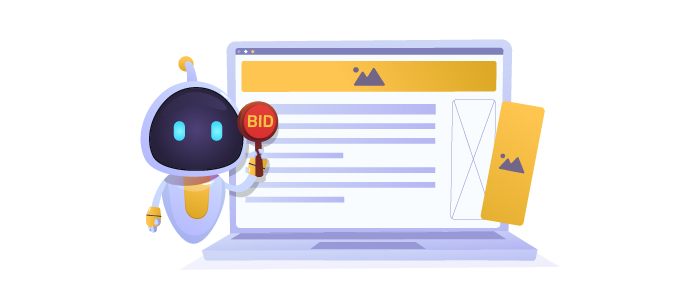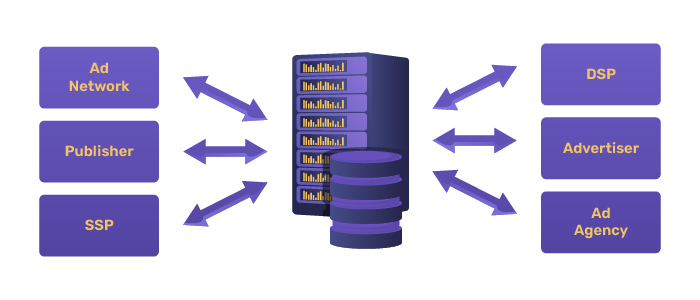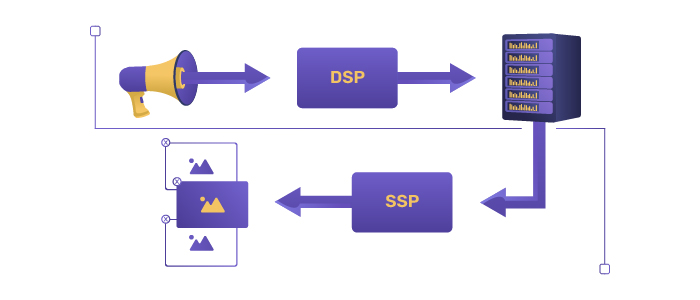Ad Network vs. Exchange vs. DSP: Pick Your Path
Feeling lost in the labyrinth of programmatic advertising? Imagine this: you’re tasked with launching a stellar online advertising campaign. Programmatic buying is the way to go – efficient, automated, targeted – but then the acronyms start flying: Ad Networks, Ad Exchanges, DSPs… what’s the difference? Where do you even begin?
This confusion is a common pitfall, and it can leave your advertising goals feeling blurry. But fear not! This article is your escape plan.
We’ll delve into the functionalities of each solution—Ad Networks, Ad Exchanges, and DSPs—and explore their strengths and weaknesses, helping you understand the intricate dance between advertisers and publishers in the programmatic world.
By the end, you’ll be a programmatic pro, ready to confidently navigate the online advertising landscape and achieve your marketing objectives.
So, grab a cup of coffee, ditch the confusion, and let’s dive in!
Table of Contents
Ad Network vs. Ad Exchange vs. DSP at a Glance
| Ad Network | Ad Exchange | DSP |
|---|---|---|
| Traffic inventory limited by the platform’s network of Publishers. | Large traffic inventory from multiple Ad Networks. | Global traffic inventory sourced from multiple Ad Exchanges. |
| Traditional pricing negotiations. | Real-Time Bidding System. | Automated Real-Time Bidding System. |
| Low transparency regarding pricing & positioning of ads. | Hard to keep track of who buys your advertising space or displays your ads. | Steep learning curve. |
The Ad Network: A Brief History
To better understand all the different platforms available in today’s advertising industry, we first need to see what display advertising is and its role in its relationship with ad networks.
DEF. Display advertising is a type of online advertising that can take a variety of shapes and forms, from banner ads to interactive multimedia banners.
These ads are published on various websites so that users can interact with them through clicks or views, influencing the impression metrics, among other things. Initially, displaying ads was simple, as only three parties were involved: advertisers, publishers, and users.
Whenever advertisers had a project they wanted to promote, they would approach publishers and pay them in exchange for exposure, also known as ad space. As a result, the advertisers’ banners would be displayed on the publishers’ websites right in front of their visitors.
However, this process turned out to favor large publishers with huge audiences. Since advertisers wanted to display their banners to as many people as possible, most publishers were considered too small to do business with.
And that’s where ad networks came in. It all started in the ’90s when advertising agencies bought ad inventory from publishers and resold it to advertisers. At first, this was uncoordinated and nearly impossible to track, but the situation changed in 1995 when Doubleclick appeared and became the first internet ad-serving platform.
What Are Ad Networks and How Do They Work?

DEF. An ad network represents a network of websites on which advertisers can show ads. The network’s algorithm handles the ads according to the advertiser’s budget and targeting criteria.
Initially, ad networks partnered with publishers regardless of size, creating centralized networks that delivered traffic to advertisers.
As such, ad networks buy traffic inventory from publishers, segment it, and then sell it to advertisers in bulk based on CPC (Cost per Click) or CPM (Cost per Thousand Impressions) models.
And just like that, both parties were happy:
- Advertisers got the exposure they wanted;
- Publishers got an extra revenue stream;
- Users enjoyed their served targeted content.
What About the Users?
As it turned out, grouping a large number of publishers who don’t have similar content wasn’t very user-friendly. Usually, the ads displayed had nothing to do with the website content it was being displayed on.
This disrupted the targeted audience, the ads, and users’ satisfaction, which drove them away from the publisher’s website and the advertiser’s ad.
Most ad networks kept their publisher network private, and advertisers had no idea what websites their ads were displayed on. As a result, advertisers’ brands were often associated with low-quality websites, which proved damaging.
As the market developed, the number of ad networks increased, fragmenting it bit by bit. Every ad network created its network of publishers, and advertising to large audiences became increasingly more challenging.

When Should You Choose an Ad Network?
An ad network is best when you want to reach an audience as broad as possible in your market without coordinating with every website where your ads will be featured.
Leaving the algorithm to place ads according to your targeting criteria will save time and energy. However, the size and budget of your campaign remain at your choice, making ad networks suitable for both small and big companies.
To name a few popular ad networks, you can choose between Amazon Publisher Services, Coinzilla Ad Network, and Epom Market.
The Benefits of the Ad Networks
1. Get access to top-ranked publishers from one dashboard
If you didn’t know by now, with the help of robust ad networks, media buyers could easily access top-notch ad spaces, inventory-specific networks, and even premium advertising networks.
2. Ad networks offer easy set-up and optimization
Saving time is essential when testing a digital product. Ad networks are known for efficient media buying, so there’s no point in wasting your time when you could use it on more high-level tasks and strategies.
3. Increased flexibility on creatives
With the help of a robust ad network, the advertisers can access and rotate their banners and other creatives to ensure increased engagement, CTR, and, thus, ROI.
This seamless process doesn’t require you to contact the publisher each time.
The Brief History of Ad Exchanges

DEF. An ad exchange is a digital marketplace where people can buy and sell advertising space based on an RTB (Real-Time Bidding) system.
As opposed to the ad network’s traditional price negotiation technique, ad exchanges are more technology-driven, as their automated systems ease the bidding process between advertisers and publishers.
Ad exchanges help publishers maximize their traffic inventory and increase the transparency of the process. They allow advertisers to buy traffic from multiple publishers without having to negotiate with each of them individually.
But the Ad Exchange System Wasn’t Perfect
The problem is that ad exchanges are a little like the Wild West. As billions of ad impressions flow through these digital marketplaces daily, keeping track of all the sellers and buyers is impossible.
Ad exchanges lack regulations, so it’s usually challenging to tell where your ads will appear or who is bidding for them.

When Should You Use an Ad Exchange?
So, in the ad network vs. ad exchange debate, the ad exchange stands for control.
Therefore, an ad exchange is the best choice to see where your ads are featured and at what cost. They give you a transparent view of where the traffic comes from and the quality of the websites your brand gets associated with.
For more control, you also can blacklist certain websites and audiences to ensure an even greater deal of authority.
Even though it seems to give you more control over your display campaigns, you should remember that advertisers and publishers are growing concerned about digital ad fraud, malware, and bot activity on ad exchanges.
The Benefits of an Ad Exchange
1. Increased demand on publisher’s inventory
The higher the demand for your ad space as a publisher, the higher the CPMs; this is the essential benefit of ad exchanges, as they open out to new possibilities.
The golden rule states that the higher the demand, the more likely you’ll receive higher bids, which directly translates to a higher yield.
2. Greater control over floor prices
Ad exchange’s function based on floor prices set by publishers, known as the CPM floor. Publishers can also shift these prices based on their choice and unsold ad space.
3. Unlock the power of automation, leaving you room to strategize better
Traditional ad space selling is time-wasting and often doesn’t offer the best revenue. However, with the proper ad exchange, automation is the key to unlocking new ROI streams.
Now, let’s move along and see whether DSPs (Demand-Side Platforms) could solve some potential pitfalls associated with ad networks or ad exchanges.
What Are Demand-Side Platforms?

DEF. A Demand-Side Platform is software used to automatically buy advertising space, thus removing ad buyers and salespeople, commonly known as programmatic advertising, from the process.
Programmatic DSPs help advertisers buy traffic or impressions from a broad network of publishers. The traffic can also be segmented based on demographics, location, or previous browsing behavior.
Therefore, DSPs are very similar to ad exchanges, meaning the bidding process occurs through an ad exchange, where publishers list their available ad space.
The DSPs then decide which spaces to buy for the advertiser and acquire them through real-time bidding. While this may sound complicated, it happens in milliseconds, and a user’s computer loads a web page.
One of the main benefits of DSPs compared to ad networks and ad exchanges is the ability to buy, serve, and track ads using a single tool.
Moreover, DSPs provide advertisers with tools to improve their campaign performance, such as contextual advertising, retargeting, or capping.

When Should You Use a DSP?
When you consider moving to a demand-side platform, you’re considering going to the next level of digital advertising. You should opt for programmatic advertising with a DSP to automate the media buying process.
As a result, the DSP will allow you to manage several ad exchanges efficiently in one dashboard, providing extensive support. Also, it prevents your budget from being wasted on exposures that guarantee little to no returns, thus improving your ROI.
However, as good as DSPs sound, they can be expensive and complex to learn and only make sense if you allocate a few thousand dollars per month to your advertising budget.
The Benefits of DSPs
1. Media buyers benefit from the access of multiple inventory sources
This is DSPs’ most significant benefit, allowing them to easily buy ad space from multiple suppliers simultaneously. Moreover, the ad-buying process is much more straightforward since the DSP manages all suppliers from one interface.
2. Real-time Bidding is the new power bank of your ad inventory
This is the thing about DPSs—programmatic advertising makes things much more accessible. It allows advertisers to place bids on ad impressions and have their campaigns up and running quickly.
Therefore, advertisers have more control and can adjust their campaigns on the go based on their performance reports.
3. Detail audience targeting
Depending on the chosen DSP, DSPs help advertisers laser-target their audiences much more in-depth through custom filters or other adjustments.
Moreover, custom audiences allow you to select your publishers, thus ensuring you don’t waste your budget on irrelevant ads and placements.
SIDENOTE. While advertisers have DSPs, publishers have SSPs, also called Supply-Side Platforms. An SSP platform allows them to better manage their traffic inventory by connecting directly to numerous ad networks, exchanges, and DSPs.
Final Thoughts
So, you might wonder, are these the final days of Ad Networks and Ad Exchanges? Well, probably not. Today, most Ad Networks have incorporated numerous tools used by DSPs, such as audience targeting, impression capping, and bidding systems. Thus, we are now talking about programmatic ad networks.
At the same time, DSPs buy, repackage, and sell traffic inventory to advertisers at a premium. When it comes down to comparing them, we can see that there are only so many differences between Ad Networks, Ad Exchanges, and DSPs.
Despite their automation, DSPs will never be able to eliminate one of the most fundamental parts of advertising—human contact.